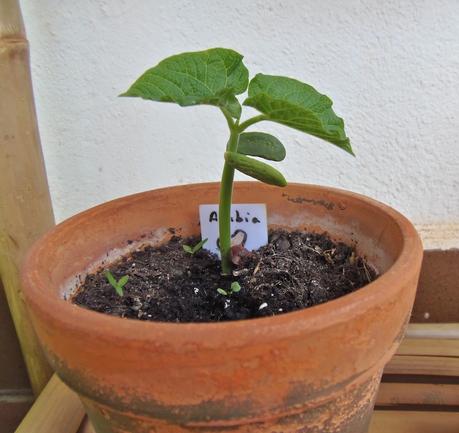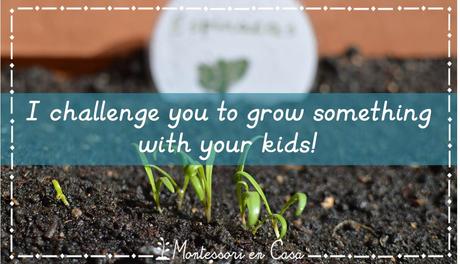
(scroll down for English)
El post de la semana pasada "¿Por qué todos los coles y hogares deberían tener un huerto?", era un intento de animar a familias y educadores a crear un huerto para cultivarlo con los niños, pero como sé que la idea de empezar a cultivar desde cero puede echar atrás a mucha gente, he decidido ir un poco más allá y lanzaros un reto para el que no vais a tener excusas, porque en este post os voy a dar sugerencias para todos los inconvenientes que me soléis plantear sobre este tema.
Si seguís el #retomontessori2015, éste es vuestro reto de Noviembre, así que tomad buena nota!
Para que no me podáis poner excusas (;P) os voy a plantear el reto en varios pasos y os voy a explicar qué hacer en cada paso en función de vuestras diferentes situaciones:
1. Decidid qué vais a sembrar
- Si estáis en el hemisferio norte, es decir, en otoño, podéis sembrar rúcula, lechuga, espinaca, acelga, rabanito, guisante, haba, ajo, cebolla, puerro, canónigos, remolacha...
- Si estáis en el hemisferio sur, es decir, en primavera, podéis sembrar rúcula, lechuga, espinaca, acelga, rabanito, guisante, judía, berenjena, calabacín, calabaza, melón, sandía, pepino, perejil, albahaca, pimiento, puerro, tomate, zanahoria...
2. Decidid dónde lo vais a sembrar
- Si vais a sembrar en el suelo tendréis que acondicionar un poco la tierra, airearla, tal vez añadirle humus o mantillo...
3. Dejad las excusas a un lado
"Es que a mí se me dan muy mal las plantas..."Si tienes un historial complicado con las plantas o si nunca antes has cultivado nada, no pasa nada! De todas las plantas que he comentado te recomiendo empezar por la rúcula, es muy fácil de cultiva y muy resistente porque es una planta muy rústica, es casi como una mala hierba, así que tus probabilidades de éxito son muchas!
"Es que no tenemos jardín, ni terraza, ni siquiera balcón..."Es cierto que con más espacio hay más posibilidades, pero si tenéis espacio para poner una maceta en la ventana o en la encimera de la cocina, no hay excusa que valga! En este caso también es una buena idea nuestra amiga la rúcula, que incluso en una maceta pequeña os dará unas cuantas hojas para animar una ensalada o un sandwich.
También podéis optar por alguna planta aromática como el tomillo, la menta, la albahaca, el orégano... O incluso por alguna planta que apenas consiga dar frutos en poco espacio (nosotros hemos conseguido cultivar alubia y girasol en macetas muy muy pequeñas!).

Recordad que el objetivo principal de este huerto no es obtener una cosecha, sino dar a los niños la oportunidad de vivir el proceso!
Aceptas el reto? Si tienes alguna duda o quieres compartir tu experiencia déjame un comentario, y si quieres retar a tus amigos comparte este post con ellos!
-----

The post of last week, "Why should every school and home have a garden?" Was an attempt to encourage families and educators to create a garden with kids, but I know that the idea to start growing something from scratch can take back a lot of people, so I have decided to go a little further and make it a challenge for which you will not have excuses, because in this post I will give suggestions for all the obstacles that you usually tell me on this subject .
So to avoid any excuses (;P) I will divide the challenge in several steps and I'll explain what to do at each step depending on your different situations:
1. Decide what you are going to grow
- If you are in the northern hemisphere, so now it's autumn, you can plant arugula, lettuce, spinach, chard, radish, pea, bean, garlic, onion, leek, lettuce, beets...
- If you are in the southern hemisphere, so now it's spring, you can plant arugula, lettuce, spinach, chard, radish, pea, bean, eggplant, zucchini, pumpkin, melon, watermelon, cucumber, parsley, basil, pepper, leek, tomato , carrot...
2. Decide where you are going to grow it
- If you are going to plant on the ground you have to put a little earth, aerating, maybe add humus ...
3. Let the excuses aside
"I've never had a green thumb..."If you have a complicated history with plants or if you've never grown anything, don't worry! Of all the plants that I mentioned I recommend you start with the arugula, it is very easy to grow and very resistant because it is a very rustic plant, it's almost like a weed, so your chances of success are many!
"I just do not have a garden, terrace or even balcony..."It is true that a bigger space has more potential, but if you have room for a pot on the window or on the kitchen counter, then you have no excuses! In this case is also a good idea to grow arugula, even in a small pot will give a few leaves to add to a salad or sandwich.
You can also opt for some aromatic herb such as thyme, mint, basil, oregano ... Or even a plant that will hardly give fruit in a small space (we have managed to grow beans and sunflowers in very very small pots!) .
Remember that the main purpose of this garden is not the harvest, but giving kids the opportunity to experience the process!
Do you accept the challenge? If you have any questions or want to share your experience leave a comment below. And if you want to challenge your friends share this post with them!
(Visited 1 times, 1 visits today)

